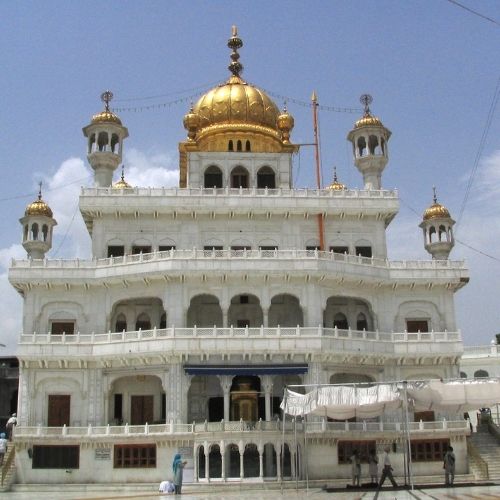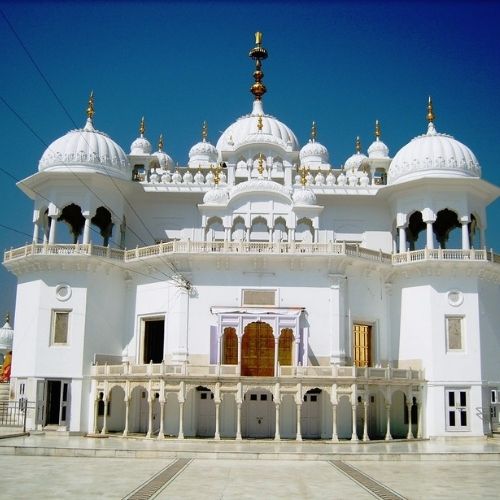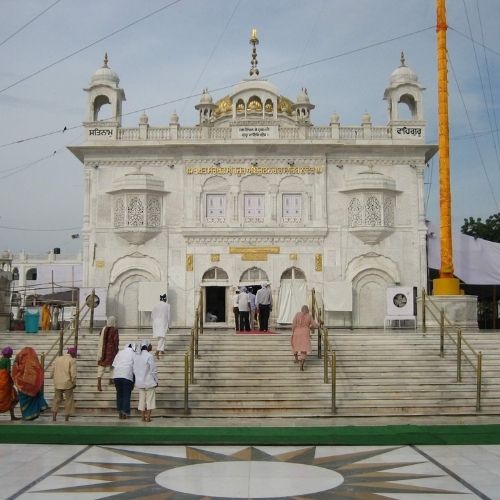Five (Panj) Takhts

Akal Takht Sahib
AKAL TAKHT: The word ‘Akal’ means, time-less (often used for Almighty-God) Takhat means a throne (seat) where the kings, emperors used to sit. Hence Akal Takhat : the seat of Almighty. Due to the excavation of the holy pool of nectar (Amrit-Sarovar), a raised place had appeared in front of Harmandir Sahib. As Guru Granth Sahib was installed in Harmandir Sahib in 1604, it was brought to this room for rest every night. Guru Arjan Dev used to rest under the cot meant for Guru Granth Sahib. This room now a days is, known as Kotha Sahib.
AKAL TAKHAT, The highest temporal seat of Sikhism was founded by the Sixth Sikh master Guru Har Gobind Sahib Ji in the year 1609, assisted by Baba Budha Ji and Bhai Gurdas. Guru named it Akal Takhat (The throne of Almighty). Guru Hargobind Sahib used to hold his court, listened to the woes of needy. Guru wore two swords of Miri and Piri at this place, the worldly emperor robe with plume on the turban, ordered the Sikhs to bring weapons, horses as offering and be saint and soldier as well. The tradition of singing ballads of war heroes with stringed instrument (Sarangi and Dhad) began at this place.
Akal Takhat has its own traditions i.e. the priest will recite the evening prayer (Rehras Sahib) and Ardas, with a naked sword in the hand. Some rare weapons pertaining to the Sikh Gurus and Sikh warriors are displayed during the day in Golden Palanquin and explained to the visitors every evening.

Takht Shri Damdama Sahib
Takhat Sri Damdama Sahib Talwandi Sabo, Bhatinda, is the seat of the authority of Sikhs. This place owes its importance to the literary work of Guru Gobind Singh Ji done here during his stay in 1706.
It was at Damdama Sahib that Guru Gobind Singh prepared the revised and authentic version of the Adi Granth which is now being honored by the Sikhs as Guru Granth Sahib, their perpetual Guru or spiritual guide or teacher. He added to the original version prepared by Guru Arjan Dev the verses of Guru Teg Bahadur. A large number of new converts joined the fold of the Khalsa here. Guru Gobind Singh stayed at Damdama Sahib for nearly a year.
One of the Five Takhats or Seat of Authority of the Sikhs. This takhat is situated at Batinda in Punjab, India and is the place where Guru Gobind Singh, the tenth Guru of the Sikhs prepared the full version of the Sikh Scriptures called Sri Guru Granth Sahib in 1705. The Damdame Wali Bir or Damdami Bir as it is sometimes called was completed here by Guru Gobind Singh. It was transcribed by Bhai Mani Singh. The hymns of Guru Tegh Bahadur Sahib, the ninth Guru and father of Guru Gobind Singh were added into the Bir.
Literally, Damdama means a place to have a break and rest. It is located at village Talwandi Sabo, 28 km southeast of Bathinda. Guru Gobind Singh stayed here after fighting battles against Mughal atrocities. Before his arrival at Talwandi, two of the Guru’s sons were bricked alive at Sarhind and two laid down their lives at Chamkaur Sahib. After writing Zafarnama, Guru Gobind Singh fought a successful battle at Muktsar and then moved towards Talwandi Sabo Ki.

Takht Shri Keshgarh Sahib
Gurdwara Shri Keshgarh Sahib (31.235169°n 76.499128°e) is located in the center of the city of Anandpur Sahib, Punjab, India. It is also known as “Takht Shri Keshgarh Sahib” and is one of five highest Sikh institutions in India; it is the city’s main Sikh shrine. The city began as Chakk Nanaki, which was founded by Guru Tegh Bahadur Ji in 1665. His son, Guru Gobind Singh ji, who spent 25 years of his life in the city, added greatly to the city’s size, giving it the new name, “City of Bliss (Anandpur).”
Its foundation stone was laid on March 30, 1689. In fact, it was here that the Khalsa Panth was born with the first initiation of Khande Di Pahul, when the young Guru called for a special congregation on the Baisakhi day of 1699 with thousands of Sikhs in attendance. One can only imagine how large the area was around Sri Keshgarh Sahib then to accommodate the many thousands of Sikhs in attendance on that historic day.

Takht Shri Hazur Sahib
Takhat Sachkhand Sri Hazoor Sahib is the principal Sikh shrine at Nanded in the Indian state of Maharashtra. It marks the site where Guru Gobind Singh had his camp in 1708, after the departure of the emperor Bahadur Shah and where, in October 2008, the 300th anniversary celebration of the Guruship of Guru Granth Sahib took place.
The tenth Guru held his court and congregation here. It is the site of his own tent where he was convalescing after he was attacked by assassins and the place at which Guru Gobind Singh ji ‘s light rose to rejoin the light of the Creator. This site is now one of five Takhats which are places of primary importance to the Sikhs. The other four takhats are: Akal Takhat at Amritsar, Takhat Keshgarh Sahib at Anandpur, Takhat Patna Sahib in Bihar District and Takhat Damdama Sahib in Talwandi Sabo, Bhatinda, Punjab

Takht Shri Patna Sahib
Guru Gobind Singh ji (22 December 1666 – 7 October 1708) was the tenth Guru of Sikhism. He was born in Patna, Bihar in India and became a Guru on 11 November 1675, at the age of nine years, succeeding his father Guru Tegh Bahadur. He was the leader of the Sikh faith, a warrior, a poet, and a philosopher. In the Sikh society, Guru Gobind Singh is considered a perfect example of manhood; highly educated, skilled in horsemanship, armed combat, chivalrous, and generous in character.
Guru Gobind Singh ji’s life and teachings have had a lasting impression on Sikh ideology as well as in their daily life. His establishment of the Khalsa is considered as one of the most important events in the history of Sikhism. He fought twenty defensive battles with the Mughals and their alliances, such as Rajas of Shivalik Hills. Guru Gobind Singh ji was the last human Sikh Guru; and in Nanded he declared the Guru Granth Sahib, the holy scripture of Sikhism, as the next permanent Sikh Guru on October 7, 1708.
